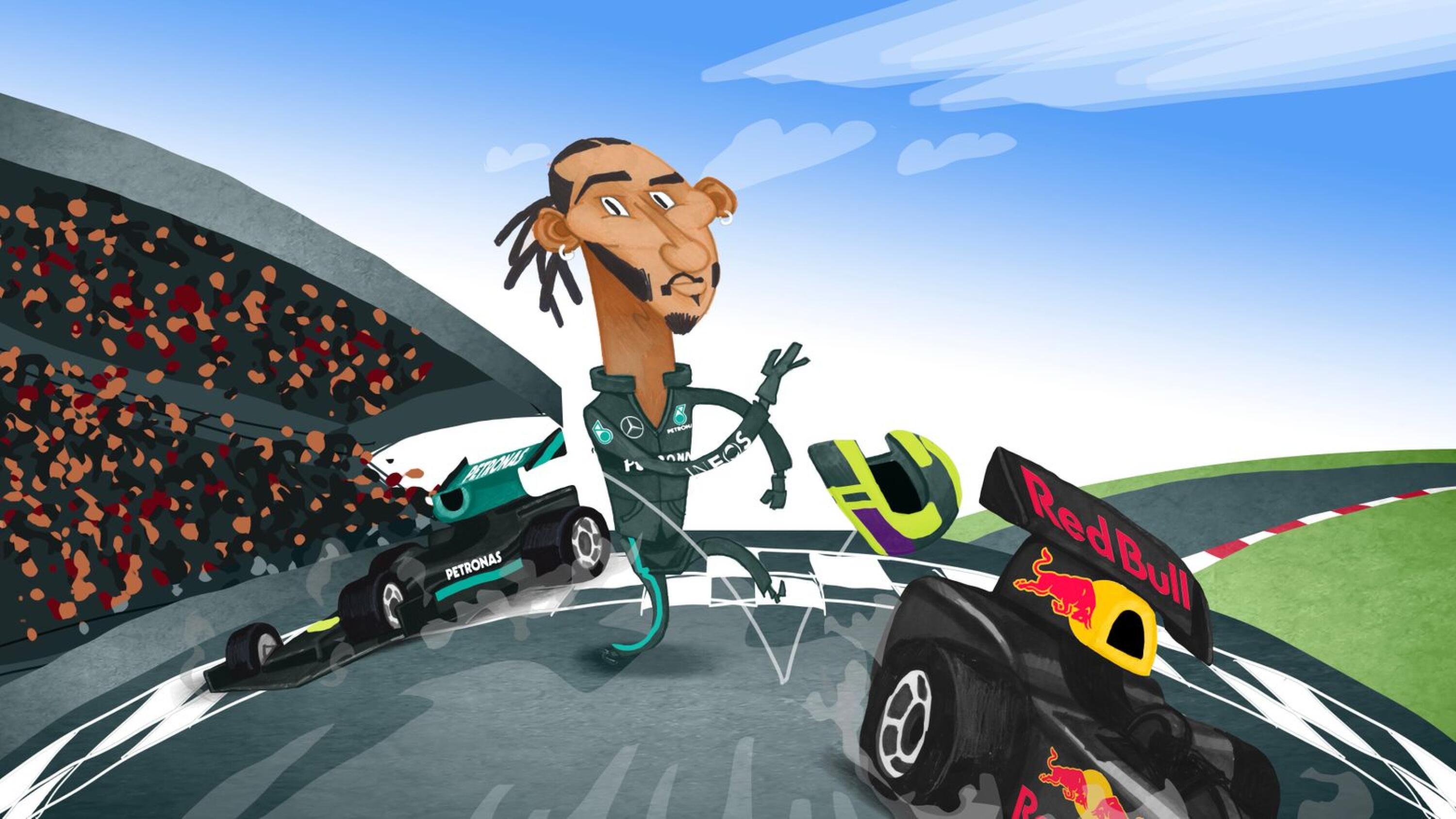Lewis Hamilton And The Transformation Of F1 Regulations

Table of Contents
Hamilton's Influence on Aerodynamic Regulations
Lewis Hamilton's dominance, often achieved through masterful car control and exploiting aerodynamic advantages, has consistently pushed the boundaries of Formula 1 regulations. His career serves as a case study in how a driver's performance can directly influence rule changes aimed at promoting closer racing and preventing runaway dominance.
The Dominance of Brawn GP and the Subsequent Changes
The 2009 Formula 1 season witnessed the unexpected triumph of Brawn GP, largely due to their innovative double-diffuser technology. This revolutionary design generated significantly more downforce, leading to a substantial performance advantage. While Hamilton wasn't driving for Brawn GP that year, his subsequent battles against their drivers highlighted the need for regulatory adjustments. The success of Brawn GP forced the FIA (Fédération Internationale de l'Automobile) to react swiftly.
- Reduction in diffuser height: The regulations were amended to reduce the height of the diffuser, thus limiting its aerodynamic effectiveness.
- Restrictions on diffuser design: Further restrictions were placed on the design and complexity of diffusers to prevent similar breakthroughs in future seasons.
- Increased scrutiny of aerodynamic components: More stringent testing and regulations were implemented to prevent teams from finding loopholes and gaining an unfair advantage.
Hamilton, driving for McLaren in 2009, had to adapt his driving style to the new aerodynamic landscape. His performance, despite not being in the dominant car, still highlighted the impact of these rule changes. The 2009 season serves as a prime example of how a technological leap, even if not directly connected to Hamilton's team, ultimately triggered sweeping regulatory changes in Formula 1.
The Ongoing Evolution of Aerodynamics and Hamilton's Contribution
The evolution of aerodynamic regulations continued throughout Hamilton's career. The introduction of wider cars in 2017, along with ongoing efforts to reduce downforce and improve overtaking opportunities, reflects a continuous effort to create a more balanced and competitive field. Hamilton's driving style, characterized by exceptional car control and precision, has subtly influenced car setup and aerodynamic development strategies. His team, Mercedes, has often been at the forefront of this development, providing valuable feedback that inevitably affects the ongoing discussions regarding F1 regulations.
- Introduction of bargeboards and aero-related regulations: The introduction of more complex bargeboards and other aerodynamic elements saw corresponding changes in regulations to limit their effectiveness and promote closer racing.
- Influence of floor regulations: Changes in floor regulations, such as the 2022 changes focused on ground effect, are partly driven by the need to create more predictable and closer racing – partially a response to periods of dominance by particular teams and drivers.
- Hamilton's feedback on aerodynamic balance: Although not publicly documented extensively, Hamilton's feedback from testing and races plays a role in shaping the direction of aerodynamic development, influencing the parameters considered by the FIA in the ongoing refinement of F1's aerodynamic regulations.
Power Unit Regulations and Hamilton's Performance
The introduction of hybrid power units in 2014 marked another significant turning point in Formula 1, and once again Hamilton's career was intertwined with the subsequent regulatory changes.
The Hybrid Era and its Impact on Hamilton's Career
The shift to hybrid power units drastically altered the strategic landscape of F1 races. Energy management became a crucial factor, requiring drivers to balance performance with fuel consumption and battery deployment. Hamilton's success with Mercedes' dominant hybrid power units is undeniable and undeniably influenced the ongoing refinement and evolution of the engine regulations.
- Changes in fuel flow regulations: Restrictions on fuel flow rates and energy recovery systems have been adjusted over the years to control performance and prevent runaway dominance.
- Mercedes' dominance and its impact on rule changes: Mercedes' consistent success with their hybrid power units, largely driven by Hamilton's performance, indirectly pushed for adjustments in power unit regulations to level the playing field.
- Hamilton's contribution to understanding hybrid technology: Hamilton's prowess in extracting maximum performance from the hybrid power units helped in better understanding their potential and limitations, indirectly feeding into the development and refinement of engine regulations.
The Debate Around Engine Costs and Hamilton's Advocacy
The high cost of developing and maintaining Formula 1 power units has been a recurring point of contention, particularly for smaller teams. While Hamilton hasn't directly led the charge on this issue, his position as a prominent figure in the sport undoubtedly lends weight to the discussions surrounding cost caps and the need for more equitable engine regulations. The ongoing debates about the financial viability of competing in F1 are directly impacted by the performance, and success of top drivers like Hamilton.
Hamilton's Advocacy for Social Justice and its Influence on F1's Regulations
Beyond the technical aspects of racing, Hamilton's outspoken advocacy for social justice and diversity has had a notable impact on F1's commitment to inclusivity.
The Rise of Diversity and Inclusion Initiatives in F1
Hamilton's activism has played a crucial role in pushing F1 towards greater diversity and inclusion. His voice has amplified calls for greater representation in the sport, leading to a greater focus on diversity initiatives within teams and the governing body.
- Increased focus on diversity programs: F1 has launched initiatives aimed at attracting and supporting underrepresented groups within the sport.
- Hamilton's Commission: Lewis Hamilton's establishment of the Hamilton Commission aims to increase diversity in motorsport. This effort will directly influence the future landscape and regulatory decisions aimed at achieving a more inclusive environment.
- Representation within Teams: An increased focus on diversity within teams, driven partly by Hamilton's influence, will lead to more equitable and inclusive decision-making within the sport's organizations.
Conclusion:
Lewis Hamilton's impact on Formula 1 extends far beyond his seven world championships. His influence on the evolution of F1 regulations, from aerodynamic designs to power unit technology and even the push for improved diversity and inclusion, is undeniable. His on-track performance has challenged and shaped rulemakers, pushing the boundaries of innovation and ultimately contributing to the ongoing transformation of the sport. While his direct influence on specific regulatory changes might be debated, his indirect impact through performance, technological advancements, and social advocacy is clear. Understanding this relationship between Lewis Hamilton and F1 regulations provides crucial insight into the sport's dynamic history and future direction. Continue exploring the fascinating intersection of Lewis Hamilton and F1 regulations to gain a deeper understanding of the sport's dynamic history and future direction. Learn more about the evolving world of Lewis Hamilton F1 regulations and their impact on the sport.

Featured Posts
-
 Investigating The Link Between Climate Change And Aggressive Fungi
May 26, 2025
Investigating The Link Between Climate Change And Aggressive Fungi
May 26, 2025 -
 Memory And Forgetting In The Works Of Kazuo Ishiguro
May 26, 2025
Memory And Forgetting In The Works Of Kazuo Ishiguro
May 26, 2025 -
 Klasemen Moto Gp Pasca Kemenangan Sprint Race Marquez Di Argentina 2025
May 26, 2025
Klasemen Moto Gp Pasca Kemenangan Sprint Race Marquez Di Argentina 2025
May 26, 2025 -
 Best Office Chairs 2025 Tried Tested And Recommended
May 26, 2025
Best Office Chairs 2025 Tried Tested And Recommended
May 26, 2025 -
 The March Of The Living A Story Of Resilience Featuring Agam Berger And Daniel Weiss
May 26, 2025
The March Of The Living A Story Of Resilience Featuring Agam Berger And Daniel Weiss
May 26, 2025
